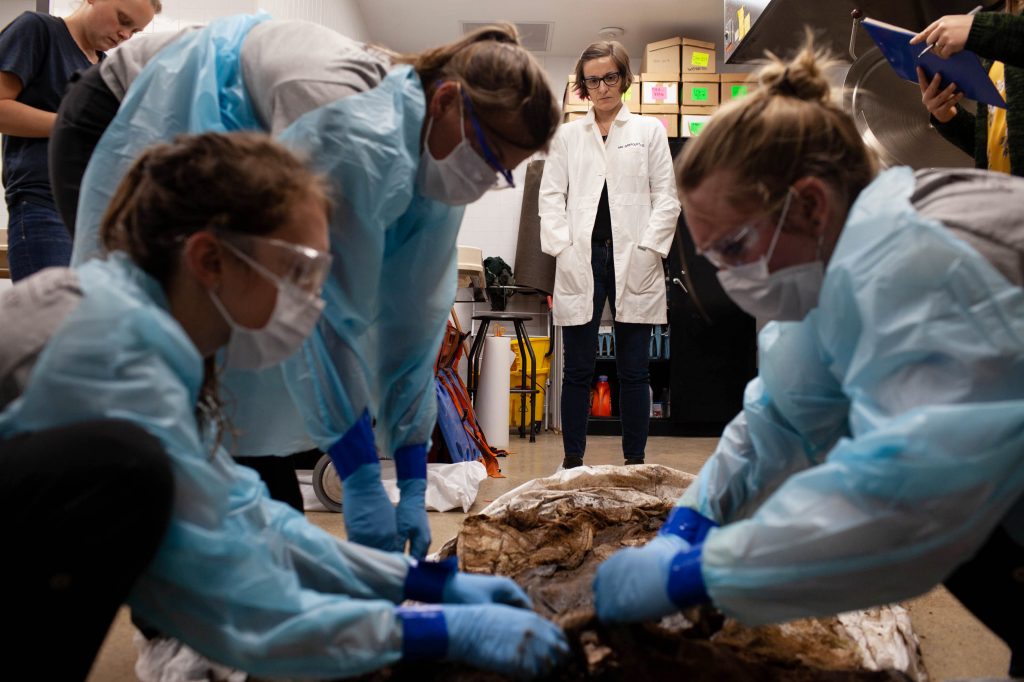Residents of Mexico and South America painstakingly traverse the Rio Grande Valley to cross into the United States, only to be left behind or buried without identifying markers after they fall ill from dehydration and overexertion. Nearly 650 deceased immigrants were found in Brooks County, Texas, located 70 miles north of the border within the last ten years (Burnett 2019).
As the number of migrants increases, so does the number of burials. Counties in the region once had the resources to bury and account for these individuals, but the overwhelming numbers left them at a disadvantage. Recently deceased undocumented migrants have been buried without a proper analysis completed, which includes extracting DNA for identification.
These graves are sometimes left unmarked, leaving it nearly impossible to find the remains should the ones who have undergone analysis be positively matched (Texas State University 2019).
Some of the aforementioned graves were exhumed by Dr. Lori Baker and Dr. Krista Latham, of Baylor University and the University of Indianapolis, respectively, in an effort to complete DNA sampling and hopefully bring families closure. Upon exhumation, they found most remains were in stages of decomposition, and therefore required proper storage until analyses could be performed. Texas State had the means to do so.
In 2013, Operation Identification, founded by the Forensic Anthropology Center at Texas State University, began its work to identify remains found along and near the southern Texas border. Dr. Kate Spradley, a biological anthropologist with an interest in forensic anthropology, leads the organization. The college currently holds 200 identified remains that Dr. Spradley and her team are working to identify (San Marcos Daily Record 2019).
As the deceased are brought to the lab, their belongs are bagged and frozen for later cleaning while the remains are sanitized. Dr. Spradley and her graduate students then use the remains to attempt to identify gender, height, age, and any physical abnormalities that may still be visible (Burnett 2019). The information is then processed through the National Missing and Unidentified Persons System (NamUs), where it will be cross-referenced with DNA from families to find a potential match. Many families are not listed in this system, but thankfully two groups, South Texan Human Rights Center and the Equipo Argentino de Antropologia Forense, have been collecting missing persons reports and DNA samples in South America, allowing a much higher chance for the remains to be matched to relatives (Garrison 2019).
As of May this year, 287 individuals have been put into the system, 31 of which have been positively identified (Burnett 2019).
References Cited
Burnett, John
2019 After Grim Deaths in the Borderlands, An Effort To Find Out Who Migrants Were. Electronic document, https://www.keranews.org/post/after-grim-deaths-borderlands-effort-find-out-who-migrants-were, accessed 5 December, 2019.
Garrison, Dale
2019 Operation Identification: Life, Death, and Lessons on the South Texas Border. http://www.evidencemagazine.com/index.php?option=com_content&task=view&id=2570&Itemid=49, accessed 5 December, 2019.
Leutert, Stephanie
2019 In the Brush in Brooks County: Who’s Dying in South Texas? Electronic document, https://www.lawfareblog.com/brush-brooks-county-whos-dying-south-texas, accessed 8 December, 2019.
San Marcos Daily Record
2019 Texas State’s Operation ID Aims To Restore Migrants’ Identities. Electronic document, https://www.sanmarcosrecord.com/news/texas-states-operation-id-aims-restore-migrants-identities, accessed December 7, 2019.
Texas State University
2019 Identifying Migrant Deaths in South Texas. Electronic document, https://www.txstate.edu/anthropology/people/faculty/spradley/Identifying-Migrant-Deaths-in-South-Texas.html, accessed 7 December 2019.
Images
Figure 1:
Leutert, Stephanie
2019 In the Brush in Brooks County: Who’s Dying in South Texas? Electronic document, https://www.lawfareblog.com/brush-brooks-county-whos-dying-south-texas, accessed 8 December, 2019.
Figure 2:
Burnett, John
2019 After Grim Deaths in the Borderlands, An Effort To Find Out Who Migrants Were. Electronic document, https://www.keranews.org/post/after-grim-deaths-borderlands-effort-find-out-who-migrants-were, accessed 5 December, 2019.
Further Readings
Lee, Jenni
2019 Texas State gets funding to help identify South Texas remains. Electronic document, https://www.kvue.com/article/news/local/texas-state-gets-funding-to-help-identify-south-texas-remains/269-15951a8f-06fb-473e-be49-ed025c6f47ca.
Regan, Mark and Lorenzo Zazueta-Castro
2019 Operation Identification Involves Immigrant Remains in Texas. Electronic document, https://www.nbcdfw.com/news/local/Operation-Identification-Involves-Immigrant-Remains-in-Texas-528669701.html.
Visit their Facebook page here.
Listen to NPR’s podcast about Operation Identification here.



I really liked this post. I think you offer a great analysis of the work anthropologists specifically have been doing in terms of migration today. I especially found your last paragraph thought provoking. As you mention, a lot of these bodies have been either buried in mass graves or left unburied without proper identification. This makes identifying bodies and returning them to their families so much more difficult because a lot of these people who have died are not going to have been reported missing considering that many are migrating “illegally” and reporting them missing could lead to family members/friends being discovered as illegal immigrants. Why do you think anthropology specifically as a field is well-situated to handle this issue? In other words, why is Anthropology so important when it comes to understanding and studying migration?
The primary reason, I believe, that the anthropological field is well-situated to assist family members with finding lost loved ones because of their training. Unlike the government, their intent is not to separate families but to bring them together. Through their specific training, they can work like Dr. Kate Spradley, either to use forensic anthropology to identify remains or use items found alongside the body to help in identification.
For understanding and studying migration, anthropologists have the unique ability to take objects migrants leave behind, and the one they choose to continue to carry and tell a story the migrant may not have had the opportunity to tell themselves. For example, Dr. Jason Leon, an anthropology professor at the University of Michigan, has imagery showing how migrants camouflage even their water bottles (Norton 2018). The average person might see this as aesthetics, while an anthropologist may understand it shows “these people are escaping death” (Norton 2018).
Hopefully, through understanding the hardships migrants endure with the help of anthropologists, the government will begin to treat them with dignity and respect.
Norton, Holly
2018 What anthropologists can tell you about the US border immigration crisis. Electronic document, https://www.theguardian.com/science/2018/jul/18/what-anthropologists-can-tell-you-about-the-us-border-immigration-crisis, accessed 15 December, 2019.